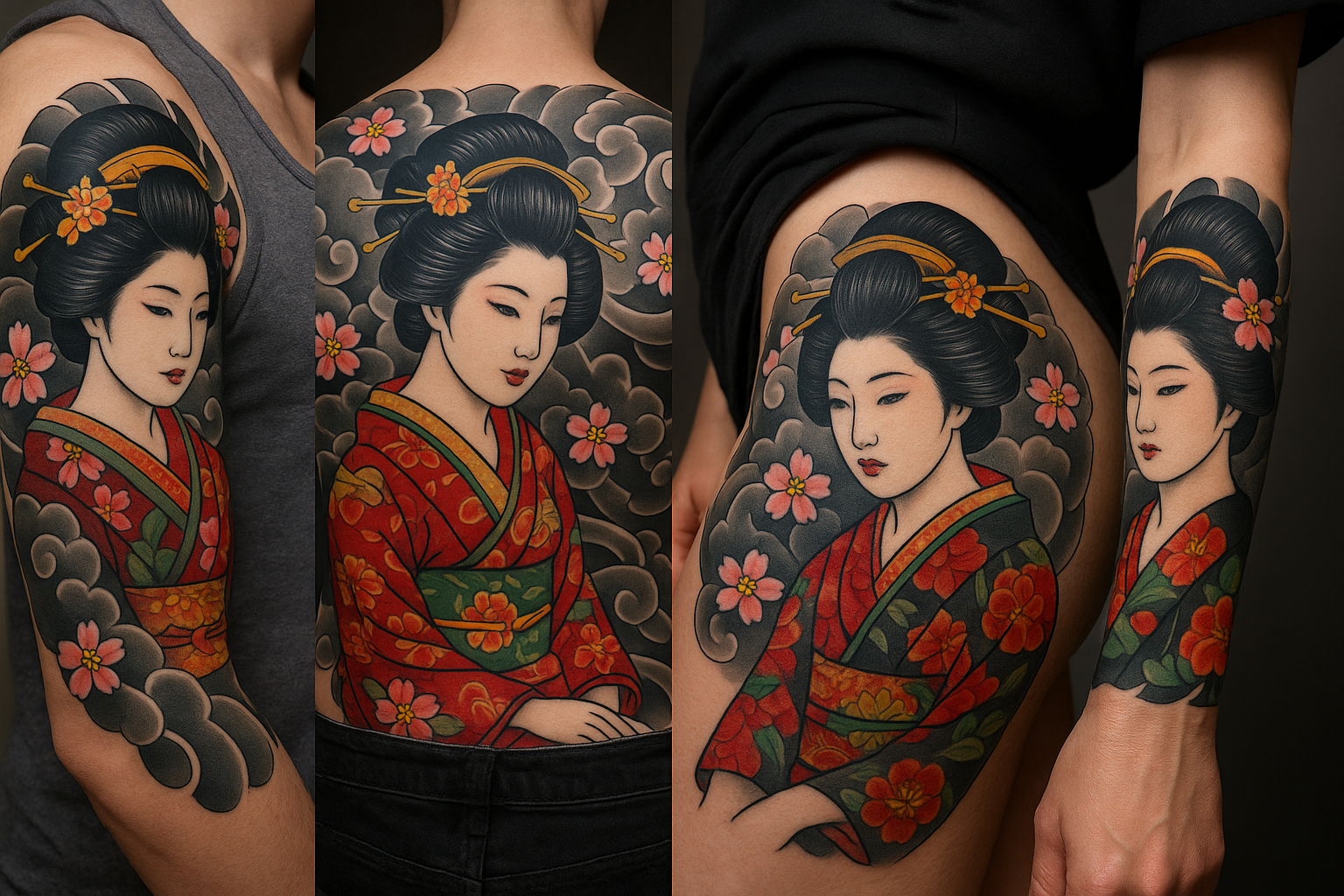Whether you’re choosing a full backpiece, a sleeve in motion, or a subtle ribcage statement, the placement of a geisha irezumi tattoo transforms its message. It frames the story, controls who sees it, and speaks volumes without ever needing words.
This post explores the most popular and meaningful placement areas for geisha tattoos in traditional Japanese irezumi style, with insight into what each area symbolizes, how it affects the design, and what kind of energy it projects.
1. Backpiece: The Private Epic
Symbolism: Hidden power, legacy, personal mythology
The full backpiece is one of the most revered canvases in irezumi. Choosing to place a geisha tattoo on your back turns her into a guardian, a silent presence that watches behind you. This is a private declaration. Only those you choose to show will ever see her fully.
Design Considerations:
- Ideal for geisha in full form, including kimono details, hair ornaments, parasols, and scene elements (cherry blossoms, fans, or even waves)
- Room for complex storytelling with flowing backdrops
- Can be paired with dragons, peonies, smoke, or even mythological creatures
Why choose it:
- You want a spiritual protector or emotional symbol close to your spine
- You value the idea of carrying a legacy on your back
- You want your geisha to be part of your soul armor, not daily display
2. Full Sleeve: The Living Scroll
Symbolism: Movement, unfolding identity, embodied storytelling
The sleeve is the most dynamic space in irezumi. It allows your geisha to move with your body. As you gesture, stretch, or reach, the lines of the tattoo come alive.
Design Considerations:
- Geisha shown in partial profile or mid-dance
- Use of negative space and flow elements (windbars, clouds) to make her motion seamless
- Background symbols like lanterns, sakura petals, or bamboo
Why choose it:
- You want your geisha to be part of your daily motion and interaction
- You resonate with the idea of living myth — her presence shifting with you
- You want visibility with nuance (long sleeves can still conceal)
3. Rib Cage: The Vulnerable Shield
Symbolism: Intimacy, resilience, pain transmuted
Geisha tattoos on the rib cage are powerful for people who associate their story with survival, secrets, or sacred pain. The ribs are close to the heart and lungs — placing a geisha here makes her a breath-witness and protector of emotional truth.
Design Considerations:
- Simplified geisha figure, often in profile
- Strong use of kimono flow to trace rib shape
- Wind, smoke, or falling petals can soften the lines
Why choose it:
- You want a private tattoo with deep personal resonance
- You see your body as a landscape of reclamation
- You’re drawn to the idea of quiet pain made sacred
4. Thigh: The Hidden Empress
Symbolism: Power through sensuality, selective revelation
The thigh is an increasingly popular location for feminine Japanese tattoos. It offers ample space for rich detail, while remaining easily concealable.
Design Considerations:
- Seated geisha, often in contemplative or sensual pose
- Intricate kimono layers and hair detail emphasized
- Use of flower beds, floor screens, or moon imagery as background
Why choose it:
- You want a tattoo that is fiercely yours, revealed only when you choose
- You identify with the duality of beauty and power
- You want to claim your leg space as soft but sovereign territory
5. Upper Arm or Shoulder Cap: The Presence Perch
Symbolism: Alertness, protection, duality
A geisha on the upper arm or shoulder often feels like a sentinel. She sits at the edge between intimacy and display, seen easily but not fully known.
Design Considerations:
- Head and shoulders portrait style
- Minimalist background (cherry blossoms, rain, wind)
- Can transition into a half sleeve or backpiece later
Why choose it:
- You want accessibility and meaning without full visibility
- You prefer smaller-scale commitment with room to expand
- You identify with the geisha as companion and protector
6. Chest or Sternum: The Internal Compass
Symbolism: Sacred center, heart-guard, breathwork
Few placements feel as raw and intentional as the sternum or chest. A geisha placed here becomes part of your core energy, facing forward as a statement of truth.
Design Considerations:
- Upright geisha, elongated for vertical space
- Flowing kimono or veil effect to soften placement
- Subtle eye contact or lowered gaze
Why choose it:
- You want to wear your heart message in ink
- You see the geisha as part of your spiritual identity
- You want your tattoo to be both armor and invitation
7. Calf or Lower Leg: The Grounded Story
Symbolism: Foundation, ancestry, forward movement
A geisha tattoo on the leg can suggest that her story walks with you. She becomes part of your direction, stepping forward as part of your lineage or resistance.
Design Considerations:
- Walking geisha with windblown kimono
- Paired elements like lanterns or bridges
- Often works well as part of a leg sleeve
Why choose it:
- You want your tattoo to travel with you, not just sit
- You resonate with geisha as ancestral symbol or guide
- You want subtlety that still holds narrative depth
Final Thoughts: Placement Is Meaning
Where you place your geisha irezumi is as important as the design itself. This isn’t just about canvas size. It’s about intention.
Ask yourself:
- Do I want this to be seen or sacred?
- Is my geisha a protector, a memory, or a mirror?
- Where do I carry my silence? My sensuality? My power?
Because when it comes to irezumi, the body isn’t just skin. It’s story space.
And your geisha deserves to live where your story matters most.


Leave a comment
Your email address will not be published. Required fields are marked *
You must be logged in to post a comment.